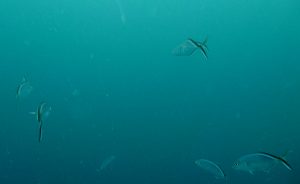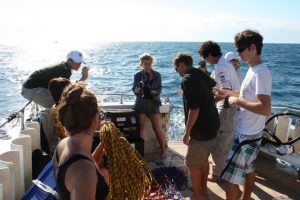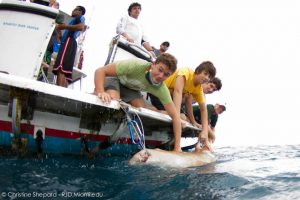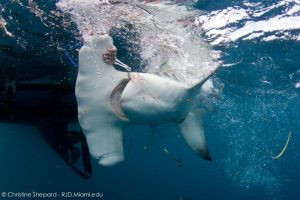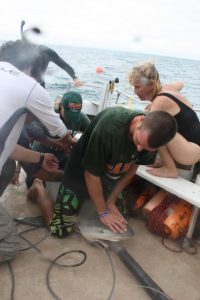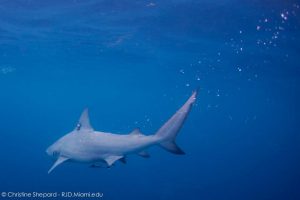About a month ago we heard from Evan Byrnes, RJD shark research intern, in his blog “Sharks, S’mores and Sleepovers.” In his blog he detailed the events of a two-day stay at the University of Miami’s Broad Key field station with students from Our Lady of Lourdes High School. Now, with the help of OLLA’s teacher, Ms. Christine Taylor, I have received an account of the trip’s events from the lovely Amanda Fernandez, a student who partook in that same trip (thanks Amanda!). Check out first hand the experience our program provides for young adults and realize that we are far more than just a research group (if you haven’t already!).My very best,
Virginia Ansaldi, RJD InternAmanda writes,The first question posed to Ms. Taylor, our brilliant science teacher, bright and early that October morning was “What is the meaning of life?” Ms. Taylor responded, “Love, happiness, and sustainability,” and I believe we accomplished all three of those components during our stay at Broad Key with the RJ Dunlap team.
Day 1: Sharking.
After arriving to Broad Key and setting our bags down inside the house we would be staying in, my group set out on the boat determined to catch some sharks! The first 10 drumlines were discouraging, as we did not catch any. Nevertheless, we lifted our spirits through shark cheers and singing. Soon enough, the sixth line of the second round of drumlines provided us with a large female nurse shark!

Interns secure a nurse shark for data collection. Photo courtsey Amanda Fernandez. Click to enlarge.
Once she was secured aboard, an air equivalent to that of an operating room engulfed the boat. Everyone had a duty, which was to be done as quickly and safely as possible. I was given the opportunity to tag my first shark and it was an irreplaceable experience. After the adrenaline rush from the first shark, we were luckily given two more opportunities with a baby nurse shark, and a fierce lemon!

Bringing the lemon to the boat. Photo courtsey Amanda Fernandez. Click to enlarge.
We returned to the island excited to exchange stories with the rest of our OLLA family! Dinner was a success thanks to Ms. Taylor’s amazing buffalo burgers and some s’mores for dessert. During our downtime, we played pool, caught the sunset, and even watched the Little Mermaid, with educational commentary of course, and then we hit the hay.
Day 2: Mangroves.
After a healthy breakfast, it was my group’s turn to explore the mangroves lining Broad Key’s front yard. Ms. Taylor pointed out visible differences between an undisturbed and a disturbed environment. She explained how disturbances are occurring in areas that are drastically affecting biodiversity, such is the case of mangroves, which serve not only as a habitat, but as a nursery for many species. After learning about salt excretion methods of mangroves, which allow these trees to survive in coastal conditions, we even got to taste the trees’ salty snack by licking the back of black mangrove leaves!
After our terrestrial fieldwork, it was time to hit the water. It was a cold and windy day, but we persisted through with fins, life vests, and our snorkel buddies. The water was murky, and at first showed few signs of sea life. We were able to see some partially dead coral, which again exemplifies the effects of harmful human actitivies.
As we squeezed through mangroves to take fish counts, we started to see a wide array of sea life: gray snappers, barracudas, and even jellyfish! Although there were times when my teeth were chattering from the cold winds, it was one of the most adventurous excursions I have ever experienced, and if I had to do it over I would do it just the same.
After getting dry and changing into warm clothes it was time for us to load up the boat for our trip home. Leaving the island was upsetting, because we would have to face the reality of our busy lives. At Broad Key, we were given the opportunity to truly appreciate nature and value its tranquility. I know I speak for the entire OLLA family when I say this: Broad Key was not only a place to enhance our learning, but we were given the opportunity to be “one with nature,” and I believe it has made all of us more determined to live more sustainably and spread our knowledge.
I would like to thank the RJ Dunlap team for all their help and patience with all of us. We learned a lot, and are truly grateful to have been given the opportunity to work with such professional and intelligent people.
Hope to see you all soon!
Amanda Fernandez, Senior at OLLA (AP Environmental Science)

